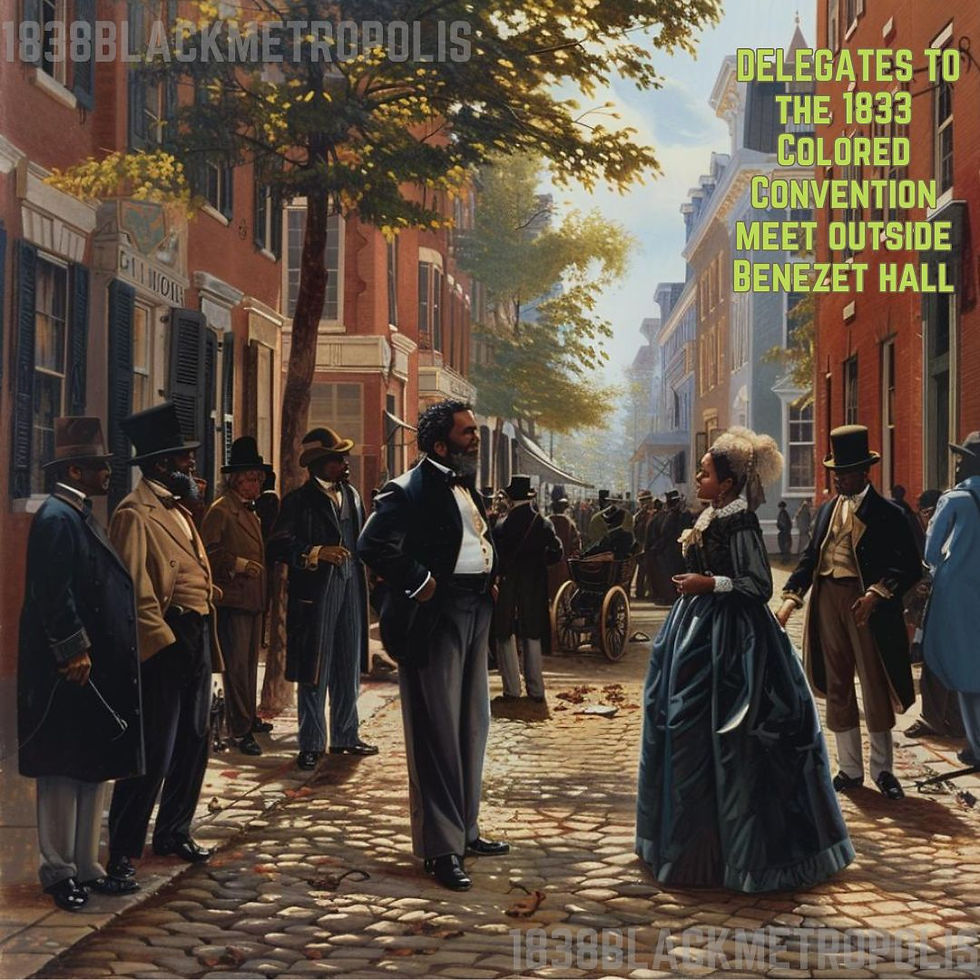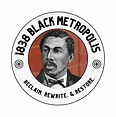Finding Benezet Hall; the Civil Rights Center You've Never Heard About
- 1838 Black Metropolis
- Mar 10, 2024
- 5 min read
Updated: Jun 7, 2024
Many of us are familiar with important Civil Rights sites from the 1960s, like the
Dexter Avenue King Memorial Church where the Montgomery bus boycott was organized. These sites become revered because the meetings they held had an impact on national history.
Did you know that there is a site here in Philadelphia that was owned and used by the Black community for civil rights and community organizing from the 1830s??
That's 120 years before the Civil Rights movement of the 1950s.
And it was a site of activity for almost 100 years. 👀

As Black people started to organize to form a sense of national identity in the 1830s, they did that at this site.
When churches, some of which are still going today, needed rooms to start before they had buildings, they did that at this site.
We often wonder how thousands of freedom seekers were able to come and land and start lives in Philadelphia from 1830-1860. Behind the scenes, economic aid and social groups were organizing - and they did that at this site.
The Banneker Institute was able to get up and running quickly - because they rented a room at this site.
When Black civil rights group the Social, Civil and Statistical Association launched in 1861, this site was its home. Many of the trolley car desegregation organizing meetings were held here.
But we don't hear about this. There's not even a historical marker.
We Black Philadelphians have been missing out on over 100 years of the organizing history of our ancestors. It's time to recognize and reclaim that heritage.
The Details
Let's take a moment to imagine it back then. It wasn't that different except that there were buildings across the street, where Starr garden is now.

SOOO much happened here on this block.
In the 1830s, colored conventions were held here and churches got started here. Union Baptist, which is Marian Anderson's home church, got started here. Many other churches continued to use the space for additional meeting space. In 1838, when Pennsylvania Hall burned, this site took up the mantle and became that envisioned community organizing space that had been lost. Starting In the 1840s, beneficial societies bought a house here for offices. In the 1850s, the Banneker institute first met here. And anti-slavery meetings where held here too. Black Philanthropy was located here - if you needed money to go to the dentist, or to pay your rent, you could talk to groups located here for help. In the 1860s, civil rights groups met and organized here. In the 1870s it was used for all of these things.
Here are just some of the many ways Benezet Hall served the community.
Politically
Benezet hall was the site of the 3rd Colored Convention in 1833.


Later it was where the Social, Civil and Statistical Association met to plan Civil Rights actions, like this meeting from 1861.

It was also considered to be the continuation of the spirit of Pennsylvania Hall, after Pennsylvania Hall was destroyed by white racist mobs in 1838.

In that spirit, it held many abolition meetings. Like this one from 1833.

Educationally
The Banneker Institute held it's first meetings at Benezet hall before its move to 11th street.

Socially
There are years of notices in Black newspapers about community meetings at Benezet Hall.

It was also home to the Hiram Lodge, the second Prince Hall Lodge in Philadelphia.

Religiously
Mother Bethel AME rented space in Benezet Hall. This July 1841 note from the Appointment of Ministers Book shows all floors rented throughout the week.

Union Baptist used Benezet Hall as their first space before they got their own church buildings in the 1830s. Other churches, like First African Presbyterian, routinely rented rooms in the hall for church activities.

Economically
It was the home of the Benezet Philanthropic Association and the Benezet Joint Stock Association. The organizations gave loans, paid for medical services and provided rental assistance to the community.


Attacked Because of Its Importance
And Benezet Hall was once burned down to the ground.
Because of it's importance to the Black anti-slavery organizing, it was a target of white racist mob violence - twice.
On the night of August 15, 1834, after 3 days of attacks, a mob of white men armed with cudgels and bats threatened to burn down the hall. Hiram lodge members were inside the lodge armed with weapons. In this tense showdown, where both the posse commitatus (equal to state national guard in our day), and the municipal authorities were in the crowd, the diffusing factor was Thomas Shipley, a white Quaker abolitionist, who skillfully helped authorities to diffuse the mob.
Read all about that and see the sources in our history of the 1834 mob attack.
It must have been paid off by 1854 because by then, it was being sold for $1 from the Benezet Philanthropic Association to the Benezet Joint Stock Association. Owned buildings are often passed down legally to close associates by only charging $1 so that there is legal transference of ownership.
In this case, the Benezet Philanthropic Association sold the hall for $1 to the Benezet Joint Stock Association. The Benezet Joint Stock Association became the caretakers of the hall. Used the hall as an asset, the Benezet Joint Stock Association loaned money to members and owned additional properties on Middle alley Elizabeth street that they rented out.
Benezet Hall continued to be used for all the functions mentioned above until they sold it in 1884.

The Municipal Center of the Black Metropolis
In the research for Benezet Hall we also discovered that there were actually two houses on south 7th between Lombard and South, that were used for municipal purposes. The first was 508 South 7th - Benezet Hall.

The other was 512 South 7th Street which was used as shared office space for four beneficial societies; Harrison Benevolent Society, Rush Benevolent Society, Trustees of the African Union Lodge Number 4, Society of the Daughters of Isaiah, The Citizen Sons of the Philadelphia Association.

This means that south 7th between Lombard and South was like a municipal center for the Black metropolis. Social groups, political groups, religious groups, economic groups - all coming together in one important block.
We imagine it as a busy place, full of people going to and fro, stopping to chat up the most recent church politics, or plan civil rights actions together, or discuss ways to provide economic support to one another.

When we say the 1838 Black Metropolis is a city-within-a-city its because we clearly see the Black community's expertly organized self-governance activities during a time when white municipal authorities could not be trusted to protect Black life and property.
Timeline
September, 1830 - A three story brick building on 7th street between Bradford Alley and Lombard (no street number at this time) purchased by the Benezet Philanthropic Society.
August, 1834 - Mob attack on Benezet Hall. No damage to the property.
May, 1848 - Insurance survey taken on 512 South 7th Street by 4 beneficial societies and a Masonic lodge for joint office space.
Sometime before 1854 -Benezet Hall rebuilt.
November, 1854 - Benezet Hall sold to the trustees of the Benezet Philanthropic Association.
1884 - Benezet Hall is sold.
Preservation
The good news is that someone peeped that Benezet Hall needed protection in 1968 when it was listed Philadelphia's Register of Historic Places in 1968. There is still a bit more research and work to do validate how much the original buildings have been updated and to bring more of this knowledge to the public. Stay tuned as we will be posting more of those activities here on our site.
Sources
Campbell, A. W. (1857). Letter from A. W. campbell to william H. johnson. 36-37. Nov 14, 1857.
Daniels, W. Union baptist church to mark 128th anniversary. Philadelphia Tribune (. 10 Sep 1960: 9.).






